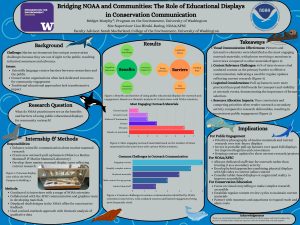Conservation in Plain Sight: Using Educational Displays to Connect NOAA and Communities
Marine environments face unique conservation challenges due to being out of sight to the public, resulting in limited awareness and advocacy compared to terrestrial ecosystems. The National Oceanic and Atmospheric Administration (NOAA) utilizes educational displays as outreach tools, but their effectiveness in bridging the gap between scientific research and public engagement remains underexplored. This study investigated the benefits and barriers of using educational displays within the Alaska Fisheries Science Center’s Marine Mammal Laboratory (AFSC/MML) to enhance public understanding of marine conservation. As a Marine Mammal Education Display Development intern at NOAA, I redesigned outdated tabletop exhibits, created new pull-up banners, and developed marine mammal skull displays that reflected current research. Through interviews with NOAA scientists and application of strategic communication frameworks, I identified key benefits of educational displays, including improved public knowledge of marine ecosystems and enhanced community engagement through interactive elements. Challenges included design limitations, logistical barriers, funding gaps, and time constraints that hindered effective outreach. Best practices emerging from this research include audience-centered design, incorporating interactive elements and visual storytelling, alongside institutional supports such as dedicated outreach roles and standardized evaluation systems. This study demonstrates how well-designed educational displays can translate complex marine conservation research into accessible public knowledge, potentially increasing support for conservation efforts. Findings provide a possible model for other agencies facing similar outreach challenges while addressing global calls for increased public engagement with conservation science, ultimately contributing to more effective stewardship of marine environments.
